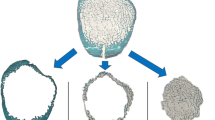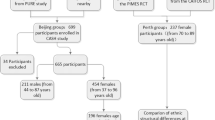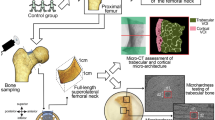Abstract
To gain insight into the growth- and age-related origins of bone fragility at the proximal femur, we analyzed structural and biomechanical data of the femoral neck from a study of postmenopausal women with hip fractures and their 47 premenopausal daughters. Results were expressed as standard deviations (SD) or Z-scores (mean ± SEM) adjusted for age and weight, derived using a normal reference population of 262 premenopausal women and 370 postmenopausal women. Women with hip fractures had increased femoral neck (FN) periosteal and endocortical diameters (1.01 ± 0.26 SD and 1.18 ± 0.25 SD, respectively). Cortical thickness was reduced by 0.96 ± 0.1 SD and volumetric bone mineral density (vBMD) was reduced by 1.2 ± 0.1 SD). The section modulus was normal while the buckling ratio was increased by 1.59 ± 0.17 SD). Their daughters had increased FN diameter by about one half that of their mothers (0.48 ± 0.16 SD), while endocortical diameter was increased by only one third (0.44 ± 0.13 SD). Cortical thickness and vBMD were not reduced, the section modulus was increased (0.48 ± 0.13 SD) while the buckling ratio was normal. We infer that the larger femoral neck size in women with hip fractures is growth-related; the wider endocortical cavity and thinner cortex is the result of excessive age-related endocortical bone resorption producing a thin cortex in a larger bone predisposing to structural failure by local buckling. The structural basis of bone fragility has some features originating during growth and others during aging.


Similar content being viewed by others
References
Seeman E (2001) Pathogenesis of bone fragility in women and men. Lancet 359:1841–1850
Hopper JL (1993) Variance components for statistical genetics: applications in medical research to characteristics related to human diseases and health. Stat Methods Med Res 2:199–223
Tabensky A, Duan Y, Edmonds J, Seeman E (2001) The contribution of reduced peak accrual of bone and age-related bone loss to osteoporosis at the spine and hip: insights the daughters of women with vertebral or hip fractures. J Bone Miner Res 16:1101–1107
Alonso CG, Curiel MD, Carranza FH, Cano RP, Perez AD (2000) Femoral bone mineral density, neck-shaft angle and mean femoral neck width as predictors of hip fracture in men and women. Osteoporos Int 11:714–720
Michelotti J, Clark J (1999) Femoral neck length and fracture risk J Bone Miner Res 10:1714–1720
Bouxsein ML, Myburgh KH, van der Meulen MC (1994) Age-related differences in cross-sectional geometry of the forearm bones in healthy women. Calcif Tissue Int 61:336–344
Beck TJ, Oreskovic TL, Stone KL, Ruff CB, Ensrud K, Nevitt MC, Genant HK, Cummings SR (2001) Structural adaptation to changing skeletal load in the progression toward hip fragility: the Study of Osteoporotic Fractures. J Bone Miner Res 16:1108–1119
Martin RB, Burr DB (1984) Non invasive measurement of long bones cross-sectional moment of inertia by photon absorptiometry. J Biomech 3:195–120
Bohr H, Schaadt O (1985) Bone mineral content of the femoral neck and shaft: relation between cortical and trabecular bone. Calcif Tissue Int 37:340–344
Bell KL, Loveridge N, Power J, Garrahan N, Stanton M, Lunt M, Meggitt BF, Reeve J (1999) Structure of the femoral neck in hip fracture: cortical bone loss in the inferoantererior to superoposterior axis. J Bone Miner Res 14:111–119
Kuiper JW, Van Kuijk C, Grashuis JL (1997) Distribution of trabecular and cortical bone related to geometry: a quantitative computed tomography study of the femoral neck. Invest Radiol 32(2):83–89
Faulkner KG, McClung M, Cummings SR (1994) Automated evaluation of hip axis length for predicting hip fracture. J Bone Miner Res 9:1065–1070
Peacock M, Turner CH, Liu G, Manatunga AK, Tiemmerman L, Johnston CC Jr (1995) Better discrimination of hip fracture using bone density, geometry and architecture. Osteoporos Int 5:167–173
Lanyon LE, Skerry T (2001) Postmenopausal osteoporosis as a failure of bone’s adaptation to functional loading: a hypothesis. J Bone Miner Res 11:1937–1947
Martin B (1993) Aging and strength of bone as structural material. Calcif Tissue Int 53[Suppl 1]:S34–S40
Rubin CT, Bain SD, McLeod KJ (1992) Suppression of the osteogenic response in the aging skeleton. Calcif Tissue Int 50:306–313
Fox KM, Cummings SR, Powell-Threets K, Stone K (1998) Family history and risk of osteoporotic fracture. Study of Osteoporotic Fractures Research Group. Osteoporos Int 8(6):557–562
Seeman E, Hopper JL, Bach L, Cooper M, McKay J, Jerums G (1989) Reduced bone mass in the daughters of women with osteoporosis. N Engl J Med 320:554–558
Seeman E, Tsalamandris C, Formica C, Hopper JL, McKay J (1994) Reduced femoral neck bone density in the daughters of women with hip fractures: the role of low peak bone density in the pathogenesis of osteoporosis. J Bone Miner Res 9:739–743
Acknowledgements
We thank senior technologists, Alison Evans and Patricia D’Souza, for their technical assistance. This work was supported by a grant from the Australia National Health and Medical Research Council (G145820).
Author information
Authors and Affiliations
Corresponding author
Rights and permissions
About this article
Cite this article
Filardi, S., Zebaze, R.M.D., Duan, Y. et al. Femoral neck fragility in women has its structural and biomechanical basis established by periosteal modeling during growth and endocortical remodeling during aging. Osteoporos Int 15, 103–107 (2004). https://doi.org/10.1007/s00198-003-1539-4
Received:
Accepted:
Published:
Issue Date:
DOI: https://doi.org/10.1007/s00198-003-1539-4




